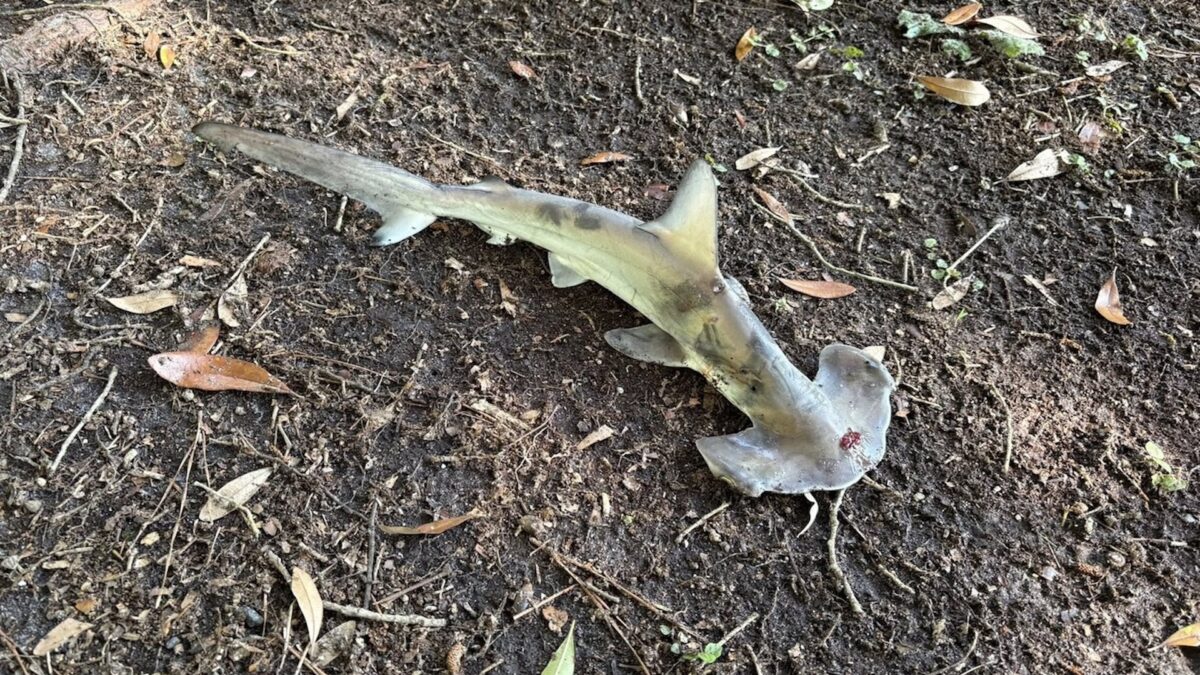Show table of content Hide table of content
In a bizarre twist that sounds straight out of a wildlife documentary, disc golfers in Myrtle Beach, South Carolina witnessed an extraordinary event when a hammerhead shark literally fell from the sky onto their course. This unusual incident occurred on June 9, 2025, creating quite the spectacle for those present at Splinter City Disc Golf Course.
Unexpected wildlife encounter on South Carolina golf course
Jonathan Marlowe was enjoying a casual round of disc golf near the 11th hole when something caught his attention overhead. What initially seemed like a typical osprey carrying its prey suddenly became memorable when the bird dropped its catch – a small hammerhead shark – directly onto the course.
“Seeing an osprey carrying prey isn’t uncommon in this area, but it’s always fascinating to watch,” Marlowe explained. “I expected it might be a regular fish, but never imagined a shark would land on our course.”
Wildlife encounters in unexpected places have become increasingly documented across the country. Just recently, a bear caused panic running through a crowded supermarket, demonstrating how wild animals occasionally venture into human spaces. However, finding a shark in the woods presents an entirely different scenario.
The hammerhead, easily identifiable by its distinctive mallet-shaped head (called a cephalofoil), appeared to be slightly longer than 12 inches. According to local marine experts, this size suggests it was a juvenile specimen. Wildlife authorities note that several hammerhead species inhabit the Atlantic waters off South Carolina’s coast.
Aerial predator drama reveals nature’s complex interactions
The mystery of how a marine predator ended up on a woodland golf course has a straightforward explanation. The osprey, sometimes called a “fish hawk,” had captured the shark from nearby ocean waters and was transporting it when the incident occurred.
Ospreys possess specialized feet designed specifically for grasping slippery aquatic prey. These raptors typically target fish smaller than 12 inches, making this hammerhead a particularly ambitious catch. The bird likely traveled at least half a mile inland before losing its grip on the meal.
Animals A female sea lion refuses to mate with a male, causing a fight and the closure of the zoo.
What caused the osprey to drop its prize? According to Marlowe, two aggressive crows chased the larger bird, forcing it to retreat to a tree where it ultimately released the shark. This behavior, known as “mobbing,” represents a common defensive strategy smaller birds employ during breeding season to protect their territories from potential predators.
Similar defensive behaviors can be observed across animal species. In one remarkable instance, an orangutan reached out to help an ecologist it thought was in danger, showing how animals sometimes interact across species boundaries.
Marlowe and his fellow disc golfers left the hammerhead where it fell, hoping the osprey might return to claim its meal. “We couldn’t believe what we’d witnessed,” Marlowe recalled. “It’s definitely a once-in-a-lifetime sight to see a shark drop from the sky while you’re playing disc golf.”
Hammerhead diversity in South Carolina waters
The shark’s unexpected appearance highlights the rich marine biodiversity along South Carolina’s coastline. According to surveys conducted by the South Carolina Department of Natural Resources between 2013 and 2016, at least three hammerhead species inhabit these waters: bonnethead (Sphyrna tiburo), scalloped hammerhead (Sphyrna lewini), and great hammerhead (Sphyrna mokarran).
Animals A wild elephant enters a convenience store and raids the food aisle.
In 2013, researchers discovered another species in these same waters – the Carolina hammerhead (Sphyrna gilbert). This rare shark closely resembles the scalloped hammerhead but possesses distinct genetic differences. Marine biologists haven’t determined which specific hammerhead species fell onto the golf course that day.
Hammerheads aren’t the only fascinating marine creatures found in these waters. In a remarkable conservation effort earlier this year, two police officers rescued a 5,000 lb fish – considered the heaviest in the world – after it became stranded on a nearby beach.
Local wildlife authorities remind residents that while seeing sharks on land represents an extremely unusual occurrence, encounters with wildlife in coastal communities happen regularly. The Myrtle Beach Disc Golf Facebook page frequently features posts about snakes, raccoons, and even alligators spotted on local courses.
Marine life and human interactions in coastal communities
This unusual shark incident represents just one example of the sometimes surprising interactions between humans and wildlife in coastal regions. As human development continues expanding into natural habitats, unexpected animal encounters become increasingly common.
Wildlife management experts emphasize the importance of respecting natural boundaries when encountering wild animals. Just as a man chased by a hungry polar bear relied on quick reflexes to save himself, understanding animal behavior can prove crucial during unexpected wildlife encounters.
Environmental conservation groups use incidents like these to highlight the delicate balance between human recreation and wildlife habitats. Sometimes what appears to be wildlife can even lead to misunderstandings, as when a clean-up team mistook a bag of stuffed animals for actual wildlife among garbage.
For the disc golfers at Splinter City that day, the falling hammerhead created an unforgettable memory and a remarkable story. While sharks typically remain in their marine environments, this unusual incident provided a reminder of nature’s unpredictability and the fascinating interconnections between aerial predators, marine life, and human recreational spaces.
As coastal development continues and climate patterns shift, wildlife biologists suggest similar unusual encounters may become more common, further blurring the lines between human spaces and natural habitats along the South Carolina coast.
Animals The world’s first genetically modified spider is capable of producing fluorescent red silk.


